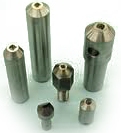A Single Point Diamond Dresser can make defining a conical or chisel point a breeze. The manufacturer recommends that the rpm speed be at least 2000 rpm when using profile-grinding wheels. A small sheet of plastic can cover the spindle carriage assembly and moulding template carrier radial adjustment to make clean-up easier after each task. Here are a few tips to use a Single Point Diamond Dresser.
Sharpening of Single Point Diamond Dresser
If you are attempting to sharpen a diamond, it is important to remember that diamonds come in various grades, and a single-point dresser is used for a range of diamond qualities. In general, different diamonds present cracks and other flaws. For best results, angle the single-point diamond dresser at a certain degree angle to the radius of the wheel, and then rotate it frequently to keep the point sharp.
Whether your diamond dresser is a single point or a multipoint dresser, the process is the same: sharpening the single-point diamond dressing wheel is necessary to maintain optimal cutting edges. Diamonds are susceptible to natural wear and tear, and a large temperature gradient will cause cracking. Fortunately, high-quality dressers can be sharpened several times, increasing their economic efficiency.

Single Point Diamond Dresser Maintenance
Maintenance of a single-point diamond dresser is a critical step in the diamond cutting process. Regular dress-ups will increase the life of your diamond and ensure trouble-free performance. The key is to maintain the ten to twenty-degree drag angle below the wheel centerline to avoid gouging and chatter marks. Also, keep in mind to keep the wheel cool. The heat generated by grinding will wear down the diamond, resulting in fracture or dulling.
Generally, single-point diamond dressers wear them until they begin to show signs of diamond fade. The onset of this fading is unpredictable. In a single, catastrophic failure, the workpiece and grinding wheel may be severely damaged. That is why most manufacturers replace their single-point diamond dressers well before the diamond fade begins. However, the dressing/truing rolls are not affected by diamond fade, so they are generally a much longer-term investment.
Defining a Conical Point on Single Point Diamond Dresser
The first step to successful diamond dressing is to define a conical point in the diamond. To determine the exact point, place the diamond dresser as close to the point as possible, and make sure to keep the dresser moving in the shank. Once you’ve achieved this, the next step is to apply a diamond dressing solution. The following method is effective for defining a conical point.
The tool is comprised of a head member and a shank. The head member has multiple facets that facilitate rotation, which allows the diamond dressing tool to achieve the right level of wear. The shank member includes front and rear recesses defined by a spring. The diamond cutting tool consists of a slug that partially encases a diamond and a carrier that carries the slug.
Defining a Chisel Point on Single Point Diamond Dresser
Defining a chiseled point is crucial when setting a diamond in a single-point diamond dresser. The diamond is lapped into place to create a precise angle and radii. In addition, this type of point also increases the tool’s life. The following information will help you determine whether your diamond is ready for a single-point dresser.
The purpose of defining a chisel point for a single-point diamond dresser is to make sure the chisel point matches the angle of the grinding wheel. The angle should be between 10 and 15 degrees above the radii of the grinding wheel.
Maintaining a Conical Point on a Single Point Diamond Dresser
Performing the dressing process of a diamond requires precision. This is why the dresser tool must rotate at least certain degrees in the shank. This process will keep the diamond surface conical and efficient. Suppliers of diamond cutting tools suggest not letting the diamond wear down till the shank is visible. If the diamond erodes to this point, it can move out of position and damage the tool.
A single-point diamond dresser is made by placing the diamond on a metal handle. It is then ground into wedges with the help of a rotating tool. The cutting angle of a diamond tip varies between 30 and 120 degrees. The angles are used for radius and form dressing.
The Bottom Line
Sharpening a single-point diamond dresser is an essential part of your diamond-cutting process. Some single-point diamond dressers are equipped with a four-angle cone to maintain a constant sharp end surface. And, the chisel point of single-point diamond dressers should be consistently sharp and set in the direction of the grinding wheel.



